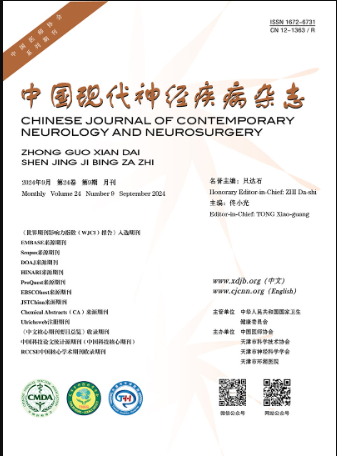Atypical lung carcinoid metastasis to the pituitary gland
Q4 Medicine
引用次数: 0
Abstract
Objective To study clinicopathological features, diagnosis and differential diagnosis of atypical lung carcinoid metastasis to the pituitary gland based on clinical data of one patient. Methods and Results A 81-year-old female presented headache and sudden blindness, and head MRI showed that there was a lesion at the saddle area. The tumor was detected at intrasellar and in grayish red during surgery. The diameter of tumor was 2 cm. The tumor was soft with no envelop at and well-defined margins, and insufficiency in blood supply. The tumor was removed completely along its edge. Under optical microscopy, the tumor was consisted of small round cells of the same size. Tumor cells were distributed around blood vessels in a nest manner or diffuse manner with brisk mitotic activity and focal necrosis. By using immunohistochemical staining, the tumor cells were diffusely positive for synaptophysin (Syn), CD56 and thyoid transcription factor - 1 (TTF - 1), focal positive for cytokeratin (CK) and P53, and negative for growth hormone (GH), prolactin (PRL), adrenocorticotropic hormone (ACTH), follicle stimulating hormone (FSH), thyroid stimulating hormone (TSH), luteinizing hormone (LH), S-100 protein (S-100), thyroglobulin (TG) and calcitonin. Ki?67 labeling index was about 33%. Conclusions Pituitary metastasis is a rare tumor, and only a few cases of atypical lung carcinoid metastasis to the pituitary gland have been reported. Definite diagnosis could be made by history, typical histopathological characteristics and immunohistochemical expressions. DOI: 10.3969/j.issn.1672-6731.2017.09.010不典型肺类癌转移至脑垂体
目的结合1例非典型肺类癌转移至垂体的临床病理特点、诊断及鉴别诊断。方法与结果81岁女性患者以头痛、突发性失明为临床表现,头部MRI示鞍区病变。术中发现肿瘤位于鞍内,呈灰红色。肿瘤直径2 cm。肿瘤质软,无包膜,边缘清晰,血供不足。肿瘤沿其边缘被完全切除。光学显微镜下,肿瘤由相同大小的小圆形细胞组成。肿瘤细胞呈巢状或弥漫性分布在血管周围,有丝分裂活跃,局灶性坏死。免疫组化染色显示肿瘤细胞突触素(Syn)、CD56、甲状腺转录因子-1 (TTF -1)弥漫性阳性,细胞角蛋白(CK)、P53局灶性阳性,生长激素(GH)、催乳素(PRL)、促肾上腺皮质激素(ACTH)、促卵泡激素(FSH)、促甲状腺激素(TSH)、促黄体生成素(LH)、S-100蛋白(S-100)、甲状腺球蛋白(TG)、降钙素(降钙素)阴性。吻吗?67贴标指数约33%。结论垂体转移是一种罕见的肿瘤,非典型肺类癌转移至垂体的病例报道较少。根据病史、典型的组织病理学特征和免疫组织化学表达可作出明确诊断。DOI: 10.3969 / j.issn.1672-6731.2017.09.010
本文章由计算机程序翻译,如有差异,请以英文原文为准。
求助全文
约1分钟内获得全文
求助全文

 求助内容:
求助内容: 应助结果提醒方式:
应助结果提醒方式:


